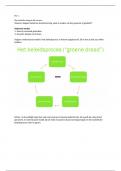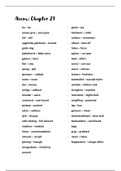Summary International Business Context (IBC)
Content
Page
Introduction 2
§1 Firm level; internalization 3
§2 National level; institutions 6
§3 National level; culture 10
§4 Firm level; corporate governance 13
,Introduction
Lecture 1 (30-3)
Context is a relative concept depending on our view of the boundary of the firm. The international
business context (IBC) is defined as those institutional, cultural and regulatory factors that explain and
influence firm’s behavior and strategy. It means that IBC is the relationship between firm level (micro,
internal, firm) and national level (macro, external, national). The internalization theory (§1) is at the
basis of this. It is the optimized bundle of transaction cost. With regards to internal control there is the
corporate governance theory (§4) which is the interplay of internal and external drivers. On the
external side there are the institutions (§2) and culture (§3). Institution refers to the factors enforced
to facilitate transactions through reducing uncertainty. Culture refers to the clusters that benefit
collective gains through prioritizing reference.
So, the focus is on two important contextual factors in international business: institution and culture
and explore how corporate governance interacts with the ‘context’.
Each topic has one or more articles in one of the four topics:
1. Founding piece; legitimize paradigm – ambiguous
2. Key development; refine or make turns – articulation
3. Review and future research; now and the future – reflection
4. Empirical tests; validate prediction – application
All four topics will be discussed in §1 - §4. They will follow the following structure:
1. Introduction to the theme
2. Discussion of the articles
3. Relations between the articles
2
, §1 Internalization
Lecture 1 (30-3), Tutorial (7-4), Article 1.1-1.3
This chapter is all about internalization. The roots of internalization lay in the transaction cost theory
by Coase (1937). However, note that internalization is just one example that is based on transaction
costs.
According to Coase market mechanisms are not cost-free: they involve transaction costs. There are
three types of transaction costs: (1) search and information, (2) bargaining and decision, and (3)
policing and enforcement. If you are able to reduce all three types of costs at the same time (e.g.
Amazon), you have a disruptive business model. On the other hand, if you have the information, but
you do not know of the information is reliable, you have the highest transaction costs.
Since the 1970’s the transaction costs changed dramatically due to the decline of transportation costs
and trade barriers. Firms and markets were able to organize a transaction with different costs. This is
where the internalization theory came in: it attempts to answer when, where, how, and what a firm
will organize (for) the transaction internally.
Internalization theory is comprised of different streams, that while having different approaches and
research domains, taken as a whole also serve a more general and versatile framework. Internalization
theory helps us both define and understand IBC, respectively by defining the boundaries of the firm
and by describing context characteristics such as industry-specific factors, country specific advantages
(CSA’s) and location advantages.
§1.1 Founding piece; Article 1.1 – Buckley et al. (1976)
The main idea of Buckley et al. (1976) is that it describes the link between the internalization and
internationalization (becoming an MNE) of the firm and the growth of multinationality. The first can
be referred to as vertical integrated producer and the latter to integration of production. According to
the authors, a market in an intermediate good will be internalized if the benefits outweigh the costs.
The benefits stem from market imperfections. According to Buckley et al. (1976) there are four groups
of factors that are relevant to the internalization decision: (1) industry-specific, (2) region-specific, (3)
nation-specific, and (4) firm-specific factors. The main emphasis in this article is on the industry-specific
factors.
Related paper question
→ according to Buckley et al. (1976), why are multinational enterprises (MNE’s) created and expanded? Among
four main groups of factors which are relevant to the internalization decisions (p. 33), which of them could be
the contextual factors? Why?
According to Buckley et al. (1976) MNE’s are created to overcome market imperfections for
intermediate products. They then internalize these markets and become MNE’s.
Buckley et al. (1976) consider four factors: (1) industry-specific, (2) region-specific, (3) nation-specific,
and (4) firm-specific factors. All the factors, except firm-specific ones, are contextual in the sense that
they define the boundaries of the firm and its interaction with the external environment. Industry-
specific factors are concerned with knowledge production, expansion and influences of the industry
on firm’s boundaries. Region- and nation-specific factors are linked to the institutional environment,
trade laws and barriers, local practices which are influenced by culture and social norms.
3
Content
Page
Introduction 2
§1 Firm level; internalization 3
§2 National level; institutions 6
§3 National level; culture 10
§4 Firm level; corporate governance 13
,Introduction
Lecture 1 (30-3)
Context is a relative concept depending on our view of the boundary of the firm. The international
business context (IBC) is defined as those institutional, cultural and regulatory factors that explain and
influence firm’s behavior and strategy. It means that IBC is the relationship between firm level (micro,
internal, firm) and national level (macro, external, national). The internalization theory (§1) is at the
basis of this. It is the optimized bundle of transaction cost. With regards to internal control there is the
corporate governance theory (§4) which is the interplay of internal and external drivers. On the
external side there are the institutions (§2) and culture (§3). Institution refers to the factors enforced
to facilitate transactions through reducing uncertainty. Culture refers to the clusters that benefit
collective gains through prioritizing reference.
So, the focus is on two important contextual factors in international business: institution and culture
and explore how corporate governance interacts with the ‘context’.
Each topic has one or more articles in one of the four topics:
1. Founding piece; legitimize paradigm – ambiguous
2. Key development; refine or make turns – articulation
3. Review and future research; now and the future – reflection
4. Empirical tests; validate prediction – application
All four topics will be discussed in §1 - §4. They will follow the following structure:
1. Introduction to the theme
2. Discussion of the articles
3. Relations between the articles
2
, §1 Internalization
Lecture 1 (30-3), Tutorial (7-4), Article 1.1-1.3
This chapter is all about internalization. The roots of internalization lay in the transaction cost theory
by Coase (1937). However, note that internalization is just one example that is based on transaction
costs.
According to Coase market mechanisms are not cost-free: they involve transaction costs. There are
three types of transaction costs: (1) search and information, (2) bargaining and decision, and (3)
policing and enforcement. If you are able to reduce all three types of costs at the same time (e.g.
Amazon), you have a disruptive business model. On the other hand, if you have the information, but
you do not know of the information is reliable, you have the highest transaction costs.
Since the 1970’s the transaction costs changed dramatically due to the decline of transportation costs
and trade barriers. Firms and markets were able to organize a transaction with different costs. This is
where the internalization theory came in: it attempts to answer when, where, how, and what a firm
will organize (for) the transaction internally.
Internalization theory is comprised of different streams, that while having different approaches and
research domains, taken as a whole also serve a more general and versatile framework. Internalization
theory helps us both define and understand IBC, respectively by defining the boundaries of the firm
and by describing context characteristics such as industry-specific factors, country specific advantages
(CSA’s) and location advantages.
§1.1 Founding piece; Article 1.1 – Buckley et al. (1976)
The main idea of Buckley et al. (1976) is that it describes the link between the internalization and
internationalization (becoming an MNE) of the firm and the growth of multinationality. The first can
be referred to as vertical integrated producer and the latter to integration of production. According to
the authors, a market in an intermediate good will be internalized if the benefits outweigh the costs.
The benefits stem from market imperfections. According to Buckley et al. (1976) there are four groups
of factors that are relevant to the internalization decision: (1) industry-specific, (2) region-specific, (3)
nation-specific, and (4) firm-specific factors. The main emphasis in this article is on the industry-specific
factors.
Related paper question
→ according to Buckley et al. (1976), why are multinational enterprises (MNE’s) created and expanded? Among
four main groups of factors which are relevant to the internalization decisions (p. 33), which of them could be
the contextual factors? Why?
According to Buckley et al. (1976) MNE’s are created to overcome market imperfections for
intermediate products. They then internalize these markets and become MNE’s.
Buckley et al. (1976) consider four factors: (1) industry-specific, (2) region-specific, (3) nation-specific,
and (4) firm-specific factors. All the factors, except firm-specific ones, are contextual in the sense that
they define the boundaries of the firm and its interaction with the external environment. Industry-
specific factors are concerned with knowledge production, expansion and influences of the industry
on firm’s boundaries. Region- and nation-specific factors are linked to the institutional environment,
trade laws and barriers, local practices which are influenced by culture and social norms.
3










